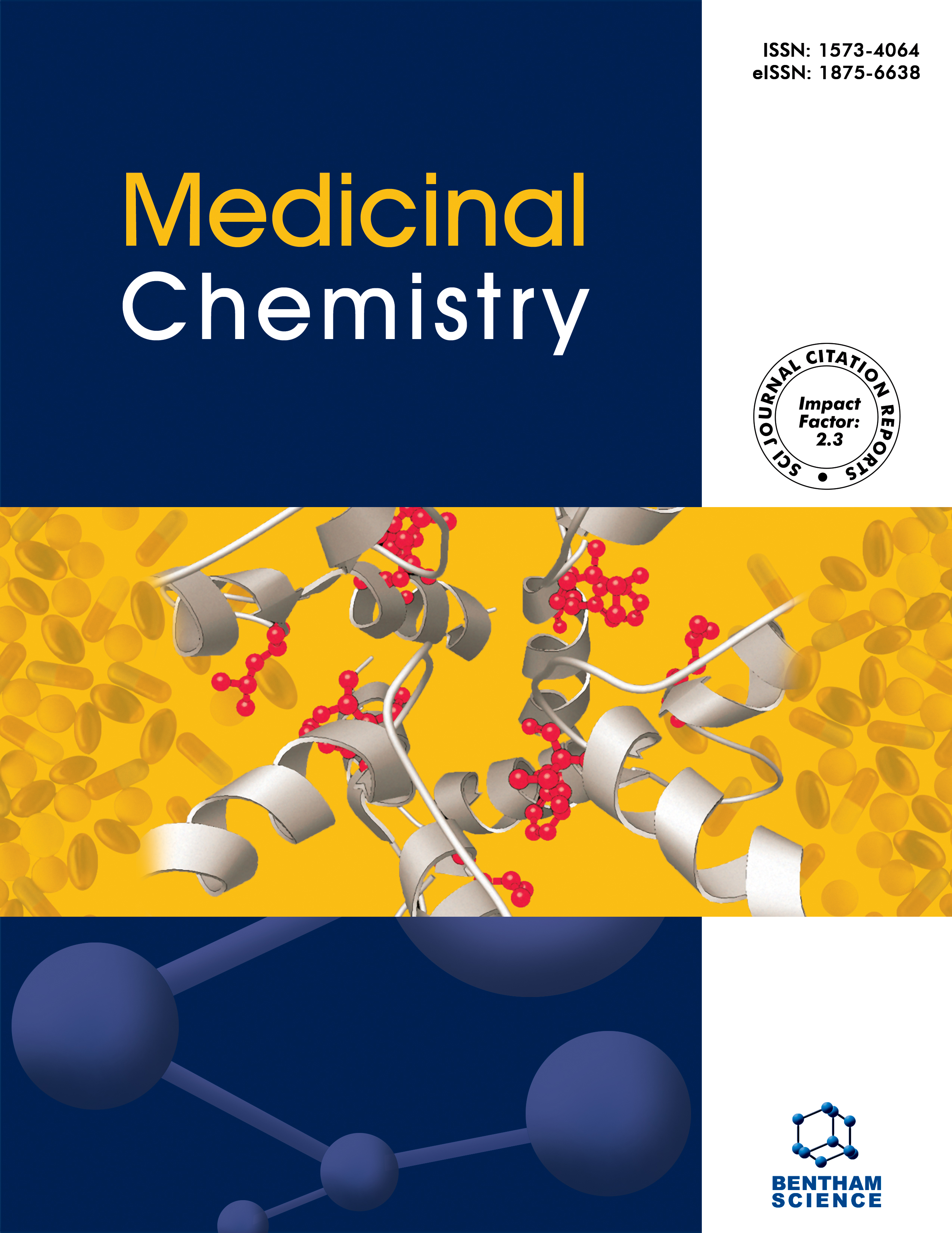- Home
- A-Z Publications
- Medicinal Chemistry
- Previous Issues
- Volume 16, Issue 2, 2020
Medicinal Chemistry - Volume 16, Issue 2, 2020
Volume 16, Issue 2, 2020
-
-
Styrylquinoline – A Versatile Scaffold in Medicinal Chemistry
More LessBackground: Styrylquinolines are characteristic fully aromatic compounds with flat, rather lipophilic structures. The first reports on their synthesis and biological activity were published roughly a century ago. However, their low selectivity, unfavorable toxicity and problems with their mechanism of action significantly hampered their development. As a result, they have been abandoned for most of the time since they were discov Read More
-
-
-
Three Dimensional Quantitative Structure Activity Relationship and Pharmacophore Modeling of Tacrine Derivatives as Acetylcholinesterase Inhibitors in Alzheimer's Treatment
More LessAuthors: Fatemeh Ansari, Jahan B. Ghasemi and Ali NiaziBackground: Three dimensional quantitative structure activity relationship and pharmacophore modeling are studied for tacrine derivatives as acetylcholinesterase inhibitors. Methods: The three dimensional quantitative structure–activity relationship and pharmacophore methods were used to model the 68 derivatives of tacrine as human acetylcholinesterase inhibitors. The effect of the docked conformer of each molecule in Read More
-
-
-
Target Based Virtual Screening of New Leads Inhibitor against Bacterial Cell Division Protein FtsZ for the Discovery of Antibacterial Agents
More LessAuthors: Ratish C. Mishra, Rosy Kumari, Shivani Yadav and Jaya P. YadavBackground: Staphylococus epidermidis coagulase negative and gram positive streptococci have emerged as major nosocomial pathogens associated with the infection of implanted medical devices and dandruff on human scalp. S. epidermidis filamenting temperature-sensitive mutant Z (FtsZ) gene encoded FtsZ protein that assembles at future bacterial cell division site that forms Z-ring structure. FtsZ is a tubulin homo Read More
-
-
-
Design and Synthesis of New Substituted Pyrazolopyridines with Potent Antiproliferative Activity
More LessBackground: Purine isosteres are often endowed with interesting pharmacological properties, due to their involvement in cellular processes replacing the natural purines. Among these compounds, pyrazolopyridines are under active investigation for potential anticancer properties. Objectives: Based on previously discovered substituted pyrazolopyridines with promising antiproliferative activity, we designed and synth Read More
-
-
-
Bicycloheptylamine-Doxorubicin Conjugate: Synthesis and Anticancer Activities in σ2 Receptor-Expressing Cell Lines
More LessAuthors: Mohammed A. Alamri, Zeynep Ates-Alagoz and Adeboye AdejareBackground: Novel bicycloheptylamines were designed and synthesized. These compounds were found to be selective for sigma-2 receptors. These receptors have been found to be up to 10 fold over-expressed in certain cancer cell lines, leading to investigation of possible uses as a biomarker in diagnosis and/or treatment especially in cancers with poor prognosis. Objectives: The aim was to conjugate a novel sigma-2 receptor lig Read More
-
-
-
Design, Synthesis, and Evaluation of Isoquinoline Ureas as TRPV1 Antagonists
More LessAuthors: Nehaben A. Gujarati, Bradley J. Undem and Vijaya L. KorliparaBackground: The inhibition of transient receptor potential vanilloid receptor 1 (TRPV1) has emerged as a novel approach for the treatment of various pain states. Pyrrolidinyl urea, SB 705498 with pKb = 7.3 in guinea pig TRPV1 receptor has been investigated in Phase II clinical trials for pain and chronic cough. Another heteroaryl urea derivative, A-425619 1, has been reported to be a potent and selective TRPV1 antagonist of Read More
-
-
-
Novel p-Functionalized Chromen-4-on-3-yl Chalcones Bearing Astonishing Boronic Acid Moiety as MDM2 Inhibitor: Synthesis, Cytotoxic Evaluation and Simulation Studies
More LessBackground: Novel 4-[3-(6/7/8-Substituted 4-Oxo-4H-chromen-3-yl)acryloyl]phenylboronic acid derivatives (5a-h) as well as other 6/7/8-substituted-3-(3-oxo-3-(4-substitutedphenyl) prop-1-enyl)-4H-chromen-4-one derivatives (3a-u) have been designed as p53-MDM2 pathway inhibitors and reported to possess significant cytotoxic properties against several cancer cell lines. Objectives: The current project aims to frame the st Read More
-
-
-
4-Aminocoumarin based Aroylthioureas as Potential Jack Bean Urease Inhibitors; Synthesis, Enzyme Inhibitory Kinetics and Docking Studies
More LessBackground: Urease enzyme catalyzes the hydrolysis of urea into ammonia and CO2, excess ammonia causes global warming and crop reduction. Ureases are also responsible for certain human diseases such as stomach cancer, peptic ulceration, pyelonephritis, and kidney stones. New urease inhibitors are developed to get rid of such problems. Objective: This article describes the synthesis of a series of novel 1-aroyl-3-(2-oxo-2 Read More
-
-
-
Synthesis of β-Ketosulfone Derivatives As New Non-Cytotoxic Urease Inhibitors In Vitro
More LessBackground: Peptic ulcer and urolithiasis are largely due to infection caused by ureaseproducing bacteria. Therefore, the discovery of urease inhibitors is an important area of medicinal chemistry research. Objective: The main aim of the work was to identify novel urease inhibitors with no cytotoxicity. Methods: During the current study, a series of β-ketosulfones 1-26 was synthesized in two steps and evaluated for their in vi Read More
-
-
-
Synthesis, Biological Evaluation and Molecular Dynamics Simulation Studies of Novel Diphenyl Ethers
More LessBackground: The well-known antibacterial agent Triclosan (TCL) that targets bacterial enoylacyl protein reductase has been described to inhibit human fatty acid synthase (FASN) via the enoylacyl reductase domain. A Literature survey indicates that TCL is selectively toxic to cancer cells and furthermore might indeed reduce cancer incidence in vivo. A recent study found that TCL inhibits FASN by acting as an allosteric protein- Read More
-
Volumes & issues
-
Volume 21 (2025)
-
Volume 20 (2024)
-
Volume 19 (2023)
-
Volume 18 (2022)
-
Volume 17 (2021)
-
Volume 16 (2020)
-
Volume 15 (2019)
-
Volume 14 (2018)
-
Volume 13 (2017)
-
Volume 12 (2016)
-
Volume 11 (2015)
-
Volume 10 (2014)
-
Volume 9 (2013)
-
Volume 8 (2012)
-
Volume 7 (2011)
-
Volume 6 (2010)
-
Volume 5 (2009)
-
Volume 4 (2008)
-
Volume 3 (2007)
-
Volume 2 (2006)
-
Volume 1 (2005)
Most Read This Month
Article
content/journals/mc
Journal
10
5
false
en


